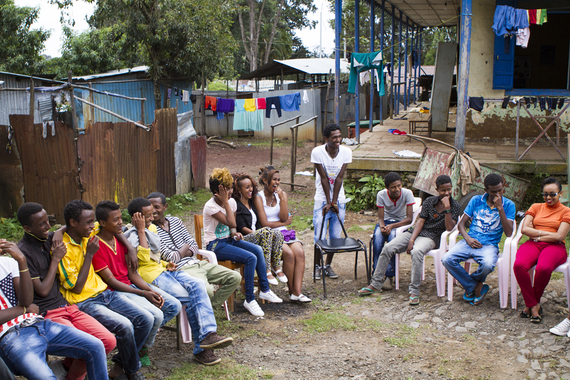Link Up aims to improve the sexual and reproductive health and rights of more than one million young people living with and most affected by HIV in Bangladesh, Burundi, Ethiopia, Myanmar and Uganda. Here's a group of young people above in Ethiopia. Credit: International HIV/AIDS Alliance
Earlier this year, young Ugandans saw an opportunity to influence the HIV response in their country by coming together to determine their priorities for the New Funding Model of the Global Fund to Fight AIDS, Tuberculosis and Malaria, a major funder of HIV programs.
The meeting included young members of "key populations," including people living with HIV, people who use drugs, sex workers, transgender persons, men who have sex with men, fisher folk and truckers, and was facilitated by young women living with HIV. These young people are rarely consulted in a meaningful way in the design and implementation of HIV/AIDS programs, even programs targeting them, in Uganda and globally.
These priorities were eventually shared in the form of a Young Key Populations Priorities Charter. The priorities identified provided a template for action that, if accepted by the Global Fund, could lead to more effective programming for young people, increased engagement by young people in policy development and national planning processes and, ultimately, genuine change on the ground.
This is one example of how young people, and particularly those living with HIV and from these key populations, are starting to engage meaningfully in the design and implementation of HIV/AIDS programs meant to help them, something long past due.
Their engagement is absolutely necessary because HIV is now the number one cause of adolescent mortality in Africa and the second biggest cause in the world (UNAIDS now defines adolescents as ages 10-19). Between 2005 and 2012, HIV-related deaths among adolescents increased by 50 percent.
But if you thought it self-evident that people targeted for a certain program should be consulted in its design and implementation, you would be wrong. "In fact, for young people most affected by HIV, it seems to me that donors and big agencies have only recently begun to recognize the value of their leadership and participation," says Luisa Orza, programs director of the ATHENA Network, which works to undertake policy work that pushes a human rights and gender equity perspective.
"When I started working in HIV 12 years ago, there wasn't any particular attention to ensuring that young people had a seat at the table. The focus has shifted to adolescents and young people much more over the last few years."
Among the reasons for the change, says Orza, is that HIV prevalence among young women ages 15-24 is so high and going up at the same time that infection rates among other groups are coming down. In Uganda, over 500 young women are acquiring HIV every week. "So the emphasis on trying to reduce HIV acquisition among that age group needs to happen and without engaging meaningfully with them, how can it?" she said.
Young people don't have access to the same spaces that older people have. Youth is another of the structural barriers where you quickly come up against a ceiling just by dint of your age. These double when you are a woman. And when you are HIV-positive, or a trans person or a sex worker, you layer in even more barriers to accessing those spaces.
Orza is working on a program called Link Up supported by the International HIV/AIDS Alliance and funded by the Netherlands' Ministry of Foreign Affairs. The project aims to improve the sexual and reproductive health of more than 1 million young people living with and most affected by HIV in Bangladesh, Burundi, Ethiopia, Myanmar and Uganda. It is one of the few programs that actively engages young members of these key populations.
Jacquelyne Alesi is one of the young Ugandans working to alleviate AIDS in Uganda by engaging these young people. She works for Link Up and facilitated the development of the Young Key Populations Priorities Charter described above. Alesi, now 28, was only a teenager when she lost her baby and then discovered she was HIV-positive. Today, Alesi is happily married, has a five-year-old son free of HIV and has become a leading youth advocate with the Uganda Network of Young People Living with HIV/AIDS.
Alesi said that young people are starting to engage in HIV/AIDS "to some extent," but "there's still a lot of work to be done. We've had young people involved in some of the policy review processes, which has been a very good step. They have been involved in the activities led by the government, which is very good."
And despite the passing of an anti-gay law in Uganda earlier this year, later struck down by the country's constitutional court, Alesi says that Link Up has been able to work with government to help vulnerable populations gain access to services.
"We've actually involved government in our planning meetings," she said. "We've been able to explain to them the populations we've been working with. The Ministry of Health is very supportive. They are really looking to us to help young key populations access [HIV/AIDS] services."
So more than 30 years into the AIDS epidemic, we are finally seeing more spaces being created, and more resources being invested, to meaningfully engage young key populations in these issues. Tailored and integrated youth-friendly HIV and sexual and reproductive health services for adolescents -- including those from the most marginalized groups -- must be prioritized if we are to bring about an end to AIDS.

